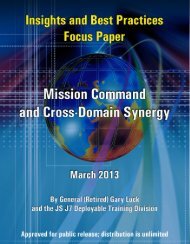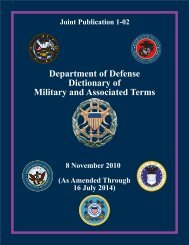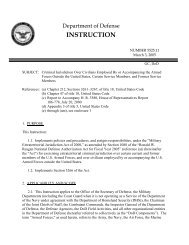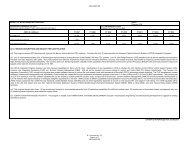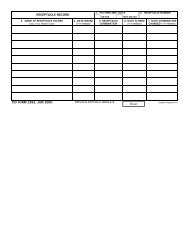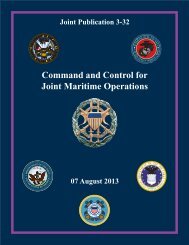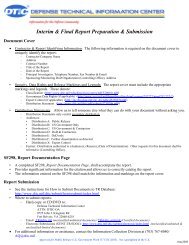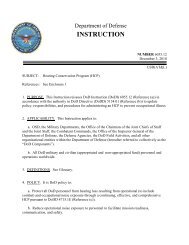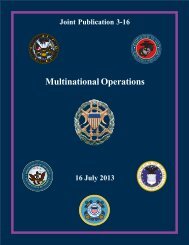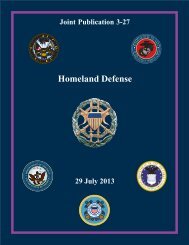JP 1, Doctrine for the Armed Forces of the United States - Defense ...
JP 1, Doctrine for the Armed Forces of the United States - Defense ...
JP 1, Doctrine for the Armed Forces of the United States - Defense ...
You also want an ePaper? Increase the reach of your titles
YUMPU automatically turns print PDFs into web optimized ePapers that Google loves.
Chapter II<br />
(1) The President <strong>of</strong> <strong>the</strong> <strong>United</strong> <strong>States</strong> is responsible to <strong>the</strong> American people <strong>for</strong><br />
national strategic direction.<br />
(a) When <strong>the</strong> US undertakes military operations, <strong>the</strong> <strong>Armed</strong> <strong>Forces</strong> <strong>of</strong> <strong>the</strong><br />
<strong>United</strong> <strong>States</strong> are only one component <strong>of</strong> a national-level ef<strong>for</strong>t involving all instruments <strong>of</strong><br />
national power. Instilling unity <strong>of</strong> ef<strong>for</strong>t at <strong>the</strong> national level is necessarily a cooperative<br />
endeavor involving a number <strong>of</strong> USG departments and agencies. In certain operations,<br />
agencies <strong>of</strong> states, localities, or <strong>for</strong>eign countries may also be involved. The President<br />
establishes guidelines <strong>for</strong> civil-military integration and disseminates decisions and monitors<br />
execution through <strong>the</strong> NSC.<br />
(b) Complex operations may require a high order <strong>of</strong> civil-military integration.<br />
Presidential directives guide participation by all US civilian and military agencies in such<br />
operations. Military leaders should work with <strong>the</strong> members <strong>of</strong> <strong>the</strong> national security team in<br />
<strong>the</strong> most skilled, tactful, and persistent ways to promote unity <strong>of</strong> ef<strong>for</strong>t. Operations <strong>of</strong><br />
departments or agencies representing <strong>the</strong> diplomatic, economic, and in<strong>for</strong>mational<br />
instruments <strong>of</strong> national power are not under command <strong>of</strong> <strong>the</strong> <strong>Armed</strong> <strong>Forces</strong> <strong>of</strong> <strong>the</strong> <strong>United</strong><br />
<strong>States</strong> or <strong>of</strong> any specific JFC. In US domestic situations, ano<strong>the</strong>r department such as <strong>the</strong><br />
Department <strong>of</strong> Homeland Security (DHS) may assume overall control <strong>of</strong> interagency<br />
coordination including military elements. Abroad, <strong>the</strong> chief <strong>of</strong> mission, supported by <strong>the</strong><br />
country team, is normally in control.<br />
(2) SecDef is responsible to <strong>the</strong> President <strong>for</strong> creating, supporting, and employing<br />
military capabilities. SecDef is <strong>the</strong> link between <strong>the</strong> President and <strong>the</strong> CCDRs, and provides<br />
direction and control <strong>of</strong> <strong>the</strong> CCDRs as <strong>the</strong>y conduct military activities and operations.<br />
SecDef provides authoritative direction and control over <strong>the</strong> Services through <strong>the</strong> Secretaries<br />
<strong>of</strong> <strong>the</strong> Military Departments. SecDef exercises control <strong>of</strong> and authority over those <strong>for</strong>ces not<br />
specifically assigned to <strong>the</strong> combatant commands (CCMDs) and administers this authority<br />
through <strong>the</strong> Military Departments, <strong>the</strong> Service Chiefs, and applicable chains <strong>of</strong> command.<br />
The Secretaries <strong>of</strong> <strong>the</strong> Military Departments organize, train, and equip <strong>for</strong>ces and provide <strong>for</strong><br />
<strong>the</strong> administration and support <strong>of</strong> <strong>for</strong>ces within <strong>the</strong>ir department, including those assigned or<br />
attached to <strong>the</strong> CCDRs.<br />
(3) The CJCS is <strong>the</strong> principal military advisor to <strong>the</strong> President, <strong>the</strong> NSC, and<br />
SecDef and functions under <strong>the</strong> authority, direction, and control <strong>of</strong> <strong>the</strong> President and SecDef.<br />
The CJCS assists <strong>the</strong> President and SecDef in providing <strong>for</strong> <strong>the</strong> strategic direction <strong>of</strong> <strong>the</strong><br />
<strong>Armed</strong> <strong>Forces</strong>. Communications between <strong>the</strong> President or SecDef and <strong>the</strong> CCDRs are<br />
normally transmitted through <strong>the</strong> CJCS.<br />
(4) CCDRs exercise combatant command (command authority) (COCOM) over<br />
assigned <strong>for</strong>ces and are responsible to <strong>the</strong> President and SecDef <strong>for</strong> <strong>the</strong> preparedness <strong>of</strong> <strong>the</strong>ir<br />
commands and per<strong>for</strong>mance <strong>of</strong> assigned missions. GCCs have responsibility <strong>for</strong> a<br />
geographic AOR assigned through <strong>the</strong> Unified Command Plan (UCP). The UCP establishes<br />
CCMD missions and responsibilities, delineates <strong>the</strong> general geographical AOR <strong>for</strong> GCCs,<br />
and provides <strong>the</strong> framework used to assign <strong>for</strong>ces. Functional combatant commanders<br />
(FCCs) have transregional responsibilities <strong>for</strong> assigned functions and support (or can be<br />
supported by) GCCs or may conduct missions assigned by <strong>the</strong> UCP independently.<br />
II-2 <strong>JP</strong> 1



